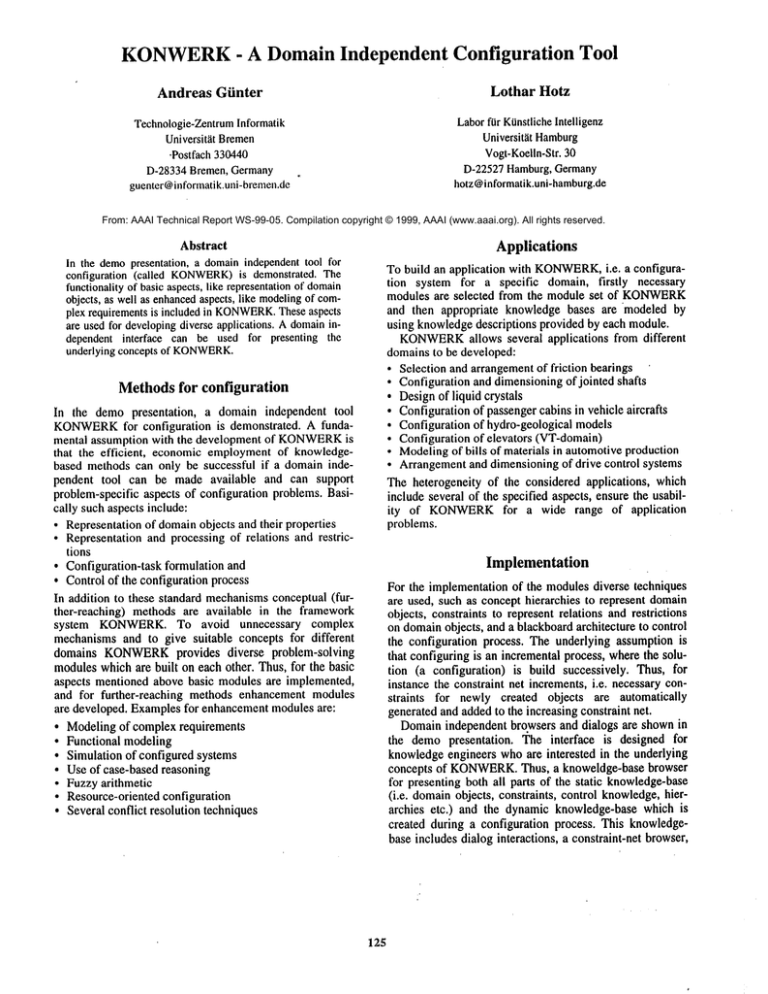
KONWERK
- A Domain Independent Configuration
Andreas
Lothar
Giinter
Tool
Hotz
Laborfur Ktinstlichelnteiligenz
Universit~tt Hamburg
Vogt-Koelln-Str.30
D-22527Hamburg,Germany
hotz @informatik.uni-hamburg.de
Technologie-Zentrum
Informatik
Universit~t Bremen
¯ Postfach330440
D-28334Bremen, Germany
guenter@informatik.uni-bremen.de
From: AAAI Technical Report WS-99-05. Compilation copyright © 1999, AAAI (www.aaai.org). All rights reserved.
Abstract
in the demopresentation, a domainindependenttool for
configuration (called KONWERK)
is demonstrated. The
functionalityof basic aspects, like representationof domain
objects, as well as enhancedaspects, like modelingof complex requirementsis included in KONWERK.
Theseaspects
are used for developingdiverse applications. A domainindependent interface can be used for presenting the
underlying concepts of KONWERK.
Methods for
configuration
In the demo presentation, a domain independent tool
KONWERK
for configuration is demonstrated. A fundamental assumption with the development of KONWERK
is
that the efficient, economic employmentof knowledgebased methods can only be successful if a domain independent tool can be made available and can support
problem-specific aspects of configuration problems. Basically such aspects include:
¯ Representation of domainobjects and their properties
¯ Representation and processing of relations and restrictions
¯ Configuration-task formulation and
¯ Control of the configuration process
In addition to these standard mechanismsconceptual (further-reaching) methods are available in the framework
system KONWERK.To avoid unnecessary
complex
mechanismsand to give suitable concepts for different
domains KONWERK
provides diverse problem-solving
moduleswhich are built on each other. Thus, for the basic
aspects mentioned above basic modules are implemented,
and for further-reaching methods enhancement modules
are developed. Examplesfor enhancementmodules are:
¯ Modeling of complex requirements
¯ Functional modeling
¯ Simulation of configured systems
¯ Use of case-based reasoning
¯ Fuzzy arithmetic
¯ Resource-oriented configuration
¯ Several conflict resolution techniques
Applications
To build an application with KONWERK,
i.e. a configuration system for a specific domain, firstly necessary
modules are selected from the module set of KONWERK
and then appropriate knowledge bases are modeled by
using knowledgedescriptions provided by each module.
KONWERK
allows several applications from different
domainsto be developed:
¯ Selection and arrangementof friction bearings
¯ Configuration and dimensioningof jointed shafts
¯ Designof liquid crystals
¯ Configurationof passengercabins in vehicle aircrafts
¯ Configuration of hydro-geological models
¯ Configuration of elevators (VT-domain)
¯ Modelingof bills of materials in automotiveproduction
¯ Arrangementand dimensioning of drive control systems
The heterogeneity of the considered applications, which
include several of the specified aspects, ensure the usability of KONWERK
for a wide range of application
problems.
Implementation
For the implementation of the modulesdiverse techniques
are used, such as concept hierarchies to represent domain
objects, constraints to represent relations and restrictions
on domainobjects, and a blackboardarchitecture to control
the configuration process. The underlying assumption is
that configuring is an incremental process, wherethe solution (a configuration) is build successively. Thus, for
instance the constraint net increments, i.e. necessary constraints for newly created objects are automatically
generatedand addedto the increasing constraint net.
Domainindependent browsers and dialogs are shown in
the demopresentation. ’Fhe interface is designed for
knowledgeengineers whoare interested in the underlying
concepts of KONWERK.
Thus, a knoweldge-base browser
for presenting both all parts of the static knowledge-base
(i.e. domainobjects, constraints, control knowledge,hierarchies etc.) and the dynamic knowledge-base which is
created during a configuration process. This knowledgebase includes dialog interactions, a constraint-net browser,
125
the elaboration net (i.e. an incremently increasing net of
partly configured objects), and a tracer for displaying configuration subtasks.
KONWERK
is written in CommonLisp, CLOS(Common Lisp Object System), and CLIM (Common Lisp
Interface Manager) and runs under WindowsNT, Windows 95, and UNIX. For non-commercial institutions
KONWERK
will be available for free from the authors.
Currently the experiences made with KONWERK
influence the developm.ent of a new commercial system called
"EngCon".
Acknowledgments
This research has been supported by the Bundesminister
fiir Bildung, Wissenschaft, Forschung und Technologie
(BMBF)under the grant 01 IN 509 D 0, INDIA- Intelligente Diagnose in der Anwendung.
References
Giinter, A. eds. 1995. Knowledge-BasedConfiguration Results of the project PROKON
(in German).Infix Verlag,
St. Augustin.
Giinter, A., Ktihn C., 1999. Knowledge-BasedConfiguration - Survey and Future Directions.
In XPS-99:
Knowledge-BasedSystems. Springer Verlag, LNAI1570.
126





